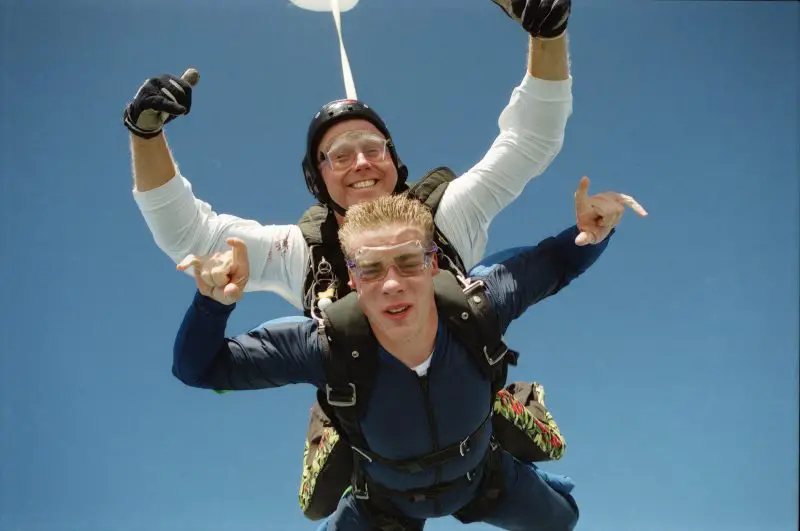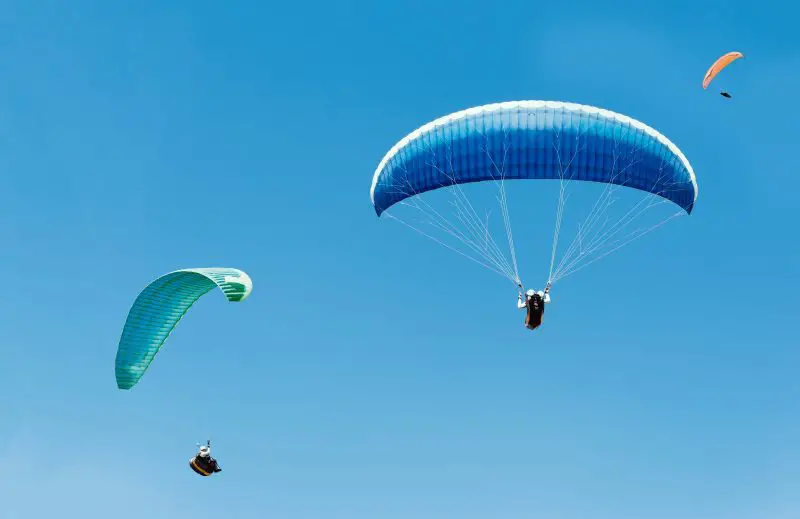It’s a funny thing about limits. Limits exist to protect us. Limits also exist to set us free. Nowhere is this truer than in skydiving. So, before you go off signing up for a skydiving adventure, read about these limits and why they will both protect you and set you free.
Essentially, there are 3 limits to protect you and free you to completely enjoy your skydiving experience: age, weight, and altitude.
How Old Do You Have to Be to Skydive?
In the United States, you need to be at least 18 years old to jump out of airplanes at drop zones that are members of the United States Parachute Association (USPA). You could think that there isn’t much difference between an 18-year-old and a 14-year-old so why the minimum age limit?
The minimum age limit is for safety, comfort, and compliance with skydiving licensing and equipment manufacturers’ regulations.
The USPA issues 4 types of skydiving licenses, from A through D, to indicate the licensees’ progressive levels of skydiving skills and accomplishments. USPA licenses are concurrent with membership and are recognized by the Federation Aeronautique Internationale. Any skydiver is considered a student until issued a license. Any skydiving center or instructor who jumps with a minor risk of losing their license.
Skydiving gear manufacturers typically require that all instructors and tandem students be at least 18 years old because their gears are built for adult-sized bodies. Tandem harnesses, although adjustable, are designed to fit securely on most adult body shapes. They generally do not fit children. So, when they’re used for minors, this poses a safety issue.
There are countries or drop zones, though, where minors are able to jump. Usually, custom harnesses have been created so minors can jump safely.
Countries that allow skydiving under the age of 18 are:
- Australia – age 12
- Canada – age 16
- France – age 16
- New Zealand – no age restriction
- Norway -age 16
- South Africa – age 16
- United Kingdom – age 16
While most skydiving centers in the United States require their guests to be at least 18 years old, there are a few that take minors. They are likely not USPA members and they use equipment by manufacturers who do not require an age minimum.
Still, special waivers for minors can be applied for with the USPA, especially for “Make A Wish Jumps”. These are by families who have young family members battling serious diseases.
In a litigious society like the United States, lawyers advise skydiving companies to avoid jumping with minors even with written parental consent. This could pose serious liability issues and costly litigation risks for the skydiving companies.
There is no maximum age limit, though, as long as you are physically and mentally fit for it. The oldest person to ever skydive, Rut Linnea Ingegard Larsson, did so at age 103, last May 29, 2022!
What Is the Weight Limit for Skydiving?
Different skydiving centers and drop zones in the United States have different limits, but generally, the absolute maximum weight limit is 250 lbs., although a 230-lb. limit is the more acceptable maximum, with a range between 225 lbs. and 275 lbs.
Skydiving weight limits are mainly determined by the gear the skydiving center uses. The gear produced by skydiving equipment manufacturers are rigorously tested first before they are issued a Technical Standard Order (TSO) by the U.S. Federal Aviation Administration (FAA). The TSO includes a maximum operating weight specification. A solo skydiving rig has a different weight restriction than a tandem skydiving rig.
Comfort is also a consideration. Typically, you freefall at 120 mph. If you’re closer to the maximum weight allowance, you will freefall faster. Once the parachute is deployed, you decelerate to around 14 mph in a few seconds. The closer to the maximum weight limit you are, the more uncomfortable the deployment. Skydiving should be fun, not painful!
Body mass index is another consideration. Although skydiving harnesses are designed for a variety of body types—wide, narrow, tall, short, light, and heavy – the person who is proportionately built in height and weight will be the most secure and will feel the most comfortable. A 6’4” tall person weighing 225 lbs. will fit into the harness differently than someone that’s fun-sized at 5’4” tall and weighs 125 lbs.

Tandem Skydiving Limits
The total weight limit for most tandem rigs is 500 lbs. This includes the weight of the instructor, the student, and the rig itself which is around 60 lbs. Risking going beyond an issued weight limit is a violation of a federally-established order. It is also very irresponsible and endangers everyone involved.
The total weight under the parachute affects the wear and tear on the equipment and influences navigation. The tandem instructor steering the parachute back to the landing area with hand-held control lines called toggles will find it more challenging to maneuver with a heavier weight. It is also harder on the instructor’s body. This is why most skydiving centers charge extra for every pound over their recommended maximum weight limit.
Altitude for Skydiving
The highest verified altitude you can skydive from in the United States is 30,000 feet, which is in the range of a standard cruising altitude of a commercial airline about 7 miles up. This is three times higher than the average skydive at 10,000 feet at 2 miles up.
Currently, this is a rare altitude offered only seasonally at one skydiving drop zone in America, SkyDance Skydiving, which is the premier destination for HALO (High Altitude Low Opening) skydiving. It’s the only drop zone in the country with a Certificate of Authorization from the FAA to fly into Reduced Vertical Separation Minimum (RSVM) airspace above 28,000 feet.
Individuals, including tandem skydivers, who want to jump from this altitude must also have an FAA Class 3 medical certificate or its equivalent, and must participate in physiological training.
Special breathing equipment is also required to jump from this altitude, since air pressure is greatly reduced at high altitudes. Hypoxia (deficiency in the amount of oxygen reaching the body tissues) risk is high. Participants must breathe pure oxygen for at least an hour before taking off, then receive oxygen supplements on their way to altitude. Generally, oxygen is required for any skydive beyond 15,000 feet, with more considerations involved the higher the altitude.
Typically, normal skydiving altitudes are between 10,000 feet to 14,000 feet. Skydiving altitudes vary among skydiving centers because of differences in the type of aircraft they use, the class of airspace the drop zones fly through, and even the weather conditions on any particular day and time.

How Safe is Skydiving?
Skydiving is much safer than most people expect. As of 2019, according to the United States Parachute Association’s (USPA) safety records, there were only 15 fatal skydiving accidents out of an estimated 3.3 million jumps, or 0.0045 fatalities for every 1,000 skydives. This translates to a solo skydiving death rate of 1 in 220,301 jumps. The tandem-related skydiving fatality rate is at 1 in 500,000 jumps.
The more common incidents are minor and non-fatal injuries. In 2019, there were 1 in 1,310 skydives that needed attention from a medical facility.
When compared with the National Security Council’s calculated odds of dying from other causes:
- Heart disease – 1 in 6
- Cancer – 1 in 7
- CoVID-19 – 1 in 12
- Motor vehicle crash – 1 in 101
- Gun assault – 1 in 221
- Electrocution, radiation, extreme temperatures, and pressure – 1 in 14,705
- Dog attack – 1 in 69,016
Skydiving is much safer, as long as all safety precautions and limits are observed. Since 2000, the rate of fatalities for every 100,000 jumps has fallen from 1.35 at its highest in 2001 to 0.39 at its lowest in 2018, with a steadily declining trend.
This may be largely attributable to the development of skydiving technology which makes skydiving much safer than the old days when skydivers used “gutter gear” or old military surplus parachute equipment!
Today, the best modern skydiving equipment include:
- Reserve parachutes as backup
- Automatic activation devices (AAD) designed to deploy the reserve parachutes automatically if the main parachute hasn’t been deployed by a predetermined altitude
- Audible altimeters to help skydivers stay aware of their altitudes during skydives
Reserve static lines (RSL) that automatically deploy the reserve parachutes as soon as the main parachute is cut away - Ram air parachutes which are rectangular, steerable, highly-maneuverable, and stable parachutes that function like fixed wings to allow greater control for landing accuracy
- Skydiving apps like Burble which show skydiving staff the location of where a skydiver has landed, if they landed off the drop zone
How do these limits free you?
When you are well within the recommended age, weight, and altitude limits for your safety and comfort, you can focus on enjoying this adventure-of-a-lifetime skydiving experience.
Skydiving is not only a high-adrenaline experience but also produces a natural high, euphoric feeling akin to good therapy. When skydiving, the brain produces endorphins, serotonin, and dopamine – all-natural chemicals that help reduce stress and anxiety.
Considering that you will only sail among the clouds for around 5 minutes, with the freefall of a skydive lasting only 60 seconds, you want to fully and freely savor these precious moments. You will, if you followed the protective limits for your safety and comfort.
So now, you can fly!
- What Size is Regular Printer Paper? Quick Guide for Paper Dimensions - June 18, 2023
- What Size is My Monitor: A Comprehensive Guide - June 18, 2023
- How Big is Italy Compared to the US? A Concise Comparison - June 16, 2023

